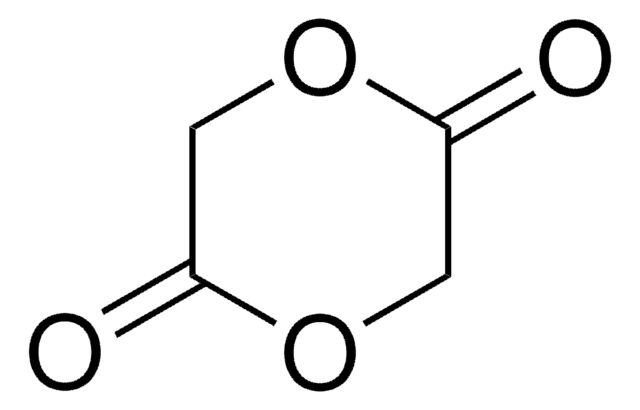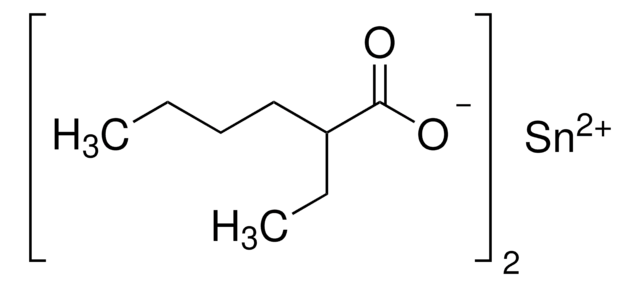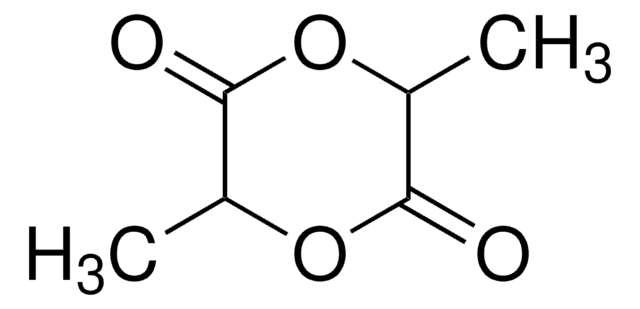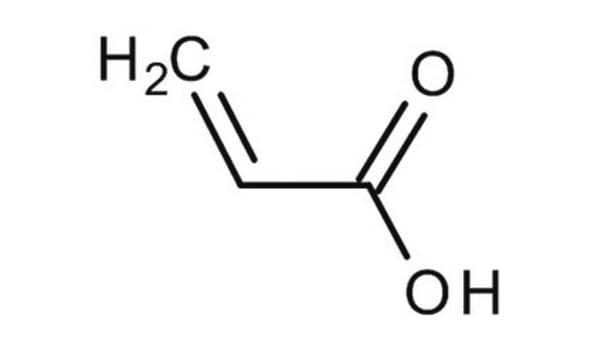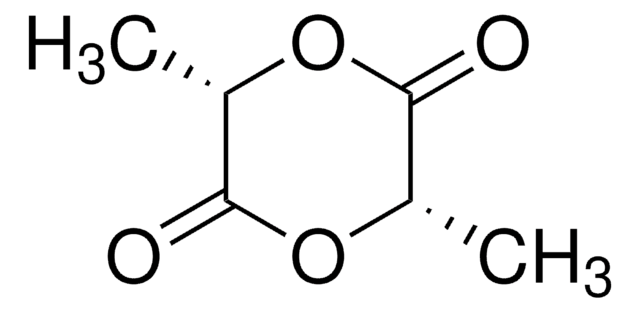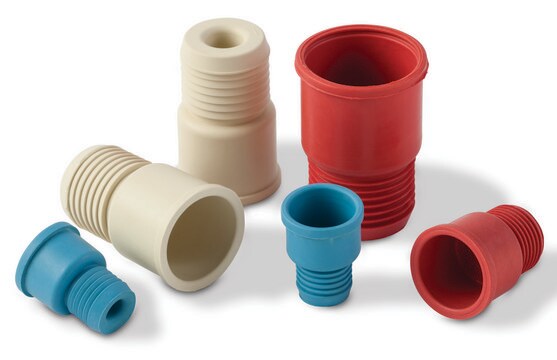919098
3-Methyl Glycolide
≥98%
Autenticatiper visualizzare i prezzi riservati alla tua organizzazione & contrattuali
About This Item
Formula empirica (notazione di Hill):
C5H6O4
Peso molecolare:
130.10
Numero MDL:
Codice UNSPSC:
12162002
NACRES:
NA.23
Prodotti consigliati
Applicazioni
3-Methylglycolide (MG) is a six-member lactone consisting of one lactyl unit (L) and one glycolyl unit (G), it is used for the synthesis of poly (lactic-co-glycolic acid) (PLGA) polymer. Polymerization of MG follows the same mechanism as that of glycolide (GA) and Lactide (LA), and the resulting polymers possess the exact alternative sequence of glycolide (GA) and Lactide (LA). PLGA based polymers made from MG perfectly avoid the drawback of structure with long glycolic blocks, exhibit excellent solubility in common organic solvents, such as acetonitrile, acetone, dioxane, DCM and THF, thus solve the long-time headache of insolubility and discoloration issues of PLGA based polymers, providing great convenience for drug delivery researches and applications.
Poly(lactic-co-glycolic acid) (PLGA) is a biocompatible and biodegradable polymer that has been approved by the FDA for biomedical and pharmaceutical applications. PLGA based polymers can be synthesized from copolymerization of glycolide (GA) and lactide (LA), and PLGAs that comprise up to a 1:1 ratio of lactic to glycolic units are of practical interest. However, the copolymerization of glycolide (GA) and Lactide (LA) typically results in broad composition ranges and a random block nature because of the much higher reactivity of GA and the drastic polymerization conditions. Thus, simple use of equimolar charges of GA and LA results in polymers containing longer glycolic blocks. This adversely affects the solubility and PDI of the copolymer. Melt copolymerization of GA and LA has often been used to prepare PLGA with high glycolic content. Under these conditions, in situ transesterification of the polymer both randomizes the sequence and broadens the distribution, as well as significant discoloration of the resulting PLGA copolymer
Poly(lactic-co-glycolic acid) (PLGA) is a biocompatible and biodegradable polymer that has been approved by the FDA for biomedical and pharmaceutical applications. PLGA based polymers can be synthesized from copolymerization of glycolide (GA) and lactide (LA), and PLGAs that comprise up to a 1:1 ratio of lactic to glycolic units are of practical interest. However, the copolymerization of glycolide (GA) and Lactide (LA) typically results in broad composition ranges and a random block nature because of the much higher reactivity of GA and the drastic polymerization conditions. Thus, simple use of equimolar charges of GA and LA results in polymers containing longer glycolic blocks. This adversely affects the solubility and PDI of the copolymer. Melt copolymerization of GA and LA has often been used to prepare PLGA with high glycolic content. Under these conditions, in situ transesterification of the polymer both randomizes the sequence and broadens the distribution, as well as significant discoloration of the resulting PLGA copolymer
Avvertenze
Warning
Indicazioni di pericolo
Consigli di prudenza
Classi di pericolo
Eye Irrit. 2
Codice della classe di stoccaggio
11 - Combustible Solids
Classe di pericolosità dell'acqua (WGK)
WGK 3
Punto d’infiammabilità (°F)
Not applicable
Punto d’infiammabilità (°C)
Not applicable
Scegli una delle versioni più recenti:
Certificati d'analisi (COA)
Lot/Batch Number
Non trovi la versione di tuo interesse?
Se hai bisogno di una versione specifica, puoi cercare il certificato tramite il numero di lotto.
Possiedi già questo prodotto?
I documenti relativi ai prodotti acquistati recentemente sono disponibili nell’Archivio dei documenti.
Synthesis of O-(2′-Bromopropionyl)glycolic Acid and Its Polymerization: Synthesis of an Alternating Lactic and Glycolic Acid Copolymer.
Rebert WN
Macromolecules, 27, 5533-5535 (1994)
Lin Yu et al.
Biomacromolecules, 12(4), 1290-1297 (2011-03-03)
This paper reports the influence of sequence structures of block copolymers composed of poly(lactic acid-co-glycolic acid) (PLGA) and poly(ethylene glycol) (PEG) on their thermogelling aqueous behaviors. A series of thermogelling PLGA-PEG-PLGA triblock copolymers with similar chemical compositions and block lengths
Il team dei nostri ricercatori vanta grande esperienza in tutte le aree della ricerca quali Life Science, scienza dei materiali, sintesi chimica, cromatografia, discipline analitiche, ecc..
Contatta l'Assistenza Tecnica.